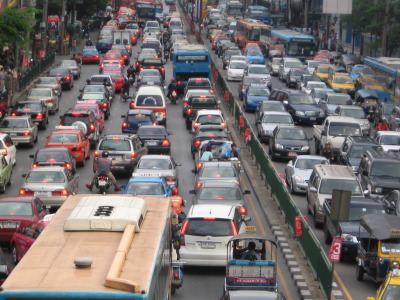Being stuck in traffic is the worst. It’s the only time you’ll see me get excited to inch forward a couple of feet before slamming on my breaks again. The cacophony of horns and shouts is enough to make anyone grumpy and overall, it’s just a colossal waste of time and gas. I would be happy to wager it’s probably everyone’s least favorite part about driving. I know I hate it, and I don’t have to be psychic to guess you do too.
So what if I told you that last year alone you and everyone else combined sat in enough traffic that you could have traveled to the moon and back two and a half times. For those of you a little rusty on your astronomy, that’s roughly 1.4 million miles of traffic. That’s entirely too much traffic.
See where I’m going with this?
I don’t have a whole lot of experience with Garmin’s live traffic, but I know TomTom’s is pretty nice. I’m not going to try and convince you any of them are the best—it really all depends on where you live, where you drive, and what works for you. My point is that if you live in a city and you drive during those black, bleak and traffic snarl-filled hours, you should probably invest in something that has some sort of traffic alert to try and keep you out of the worst of it.
Of course, there are some cities where it’s simply inevitable. TomTom helpfully suggests that if you live in Atlanta and you can’t leave your work by 4:15, you might as well just wait until 6. You’d probably get home at the same time (maybe later). But, on a slightly more helpful note, TomTom does suggest that if you MUST leave to head home, try and avoid leaving on the hour if at all possible.
Kind of makes you wonder where are those hovercars and their dozens of lanes of air traffic the Jetsons promised us, doesn’t it?


Traffic re-routing is fine if you are commuting or are otherwise familiar with the alternate routes. Garmin traffic knows, approximately, traffic conditions on main highways but assumes side streets move at their speed limit and that signals and stop signs don’t affect travel time. I’ve learned the hard way to only accept alternate routes if they are on another traffic-monitored highway. Waze/Google may be better due to crowd-sourcing – have not tried it.
Why pay for the service when you can get free service on your phone?
Also, the major players have a huge Achilles heel; they can’t route traffic off closed roads or roads without traffic (unless someone at the headquarters does an act of god). Why? When the road is closed or no traffic, the sensors aren’t reporting traffic, and the algorithms will route traffic to those roads. There’s also no serious interest in fixing this because there is no incentive. So when there’s a storm in my area (flood, tree across road, intermittent road construction), I turn off the device and just use the government resources to adjust my route. Anyways, very annoying, and none of them offer me a way to contribute to a solution that would help others.
Another fatal flaw is the driver doesn’t know if the traffic is coming real time via sensors, or history, or just the speed limit.
One of the features I like about Google Maps and Garmin (phone app), is they will tell me the junction’s estimated time. To get to my destination there are many paths. Most systems will give you alternate routes, but they don’t give you the ETA at a junction. I typically like taking the same exact path, which may be some meters longer or take 30 seconds longer. I might prefer the path for other reasons that the system doesn’t have data for, or the routing algorithm doesn’t consider. But if the app doesn’t let me know what the alternative ETA is at a junction, I can’t see if the alternate has some serious traffic to avoid; I won’t find out until I go onto the route.